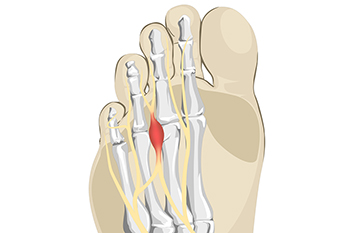
Morton's neuroma is a condition caused by the entrapment of the plantar digital nerve, typically occurring between the third and fourth toes. This nerve compression leads to pain and discomfort in the ball of the foot, often described as a burning sensation or sharp, stabbing pain. Individuals may also experience tingling or numbness in the affected toes. Diagnosis generally involves a thorough physical examination where a podiatrist may touch the area to identify tenderness or a palpable mass. Imaging techniques such as ultrasound or magnetic resonance imaging can further aid in confirming the diagnosis by visualizing the nerve and any associated swelling. If you have pain or discomfort in this area of your foot, it is suggested that you confer with a chiropodist for a diagnosis and a treatment plan.
Morton's neuroma can be highly uncomfortable. If you are experiencing the symptoms of Morton's neuroma, please consult with Emily Yu, B.Sc from Uptown Foot Care Clinic. Our specialist will assess your condition and provide you with quality foot and ankle treatment.
What Is a Morton’s Neuroma?
Morton’s neuroma is a condition in which a nerve located in the ball of the foot between the third and fourth toes thickens due to compression or irritation. Common causes of Morton’s neuroma include wearing shoes with high heels or narrow toe boxes, participating in running or court sports, an injury or trauma to the area, or pressure being placed on the nerve from foot deformities such as bunions or hammertoes. Left untreated, Morton's neuroma may result in permanent nerve damage.
Symptoms
Symptoms of Morton’s neuroma often start gradually and worsen over time. Typical symptoms include:
Foot pain
Tingling, burning, or numbness in the affected foot
The unique sensation that something is inside the ball of the foot or that there is something stuck in your shoe while walking
Treatment
Non-surgical treatments for this condition may include padding or icing the affected foot, wearing an orthotic device, modifying activities or shoes to reduce pressure on the foot, and taking medications or getting injections to reduce pain and inflammation. Surgery may be needed if non-surgical treatments are ineffective.
If you have any questions, please feel free to contact our office located in . We offer the newest diagnostic and treatment technologies for all your foot care needs.
